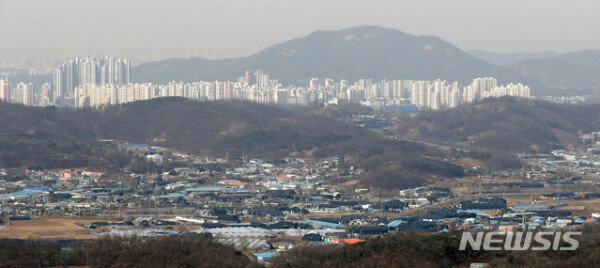The government plans to create an additional new city on a similar scale to the existing 3rd new city in order to stabilize housing prices in the metropolitan area. Traffic demand is inevitable to increase significantly. Accordingly, concerns arise that major arterial roads in the metropolitan area may fall into severe traffic congestion if special traffic measures are not prepared in advance.
● Concern about loss of function of most major roads entering Seoul as the 3rd new city
According to a report published by the Seoul Institute under the Seoul Metropolitan Government on the 2nd,’Diagnosis of Improvement Factors for Transportation in the Third New City: Focusing on the Operation of Wide-area Buses’, when the third new city enters, an additional traffic volume of about 2-3 times the planned population of each city will occur. It was estimated to be. Of these, 28-31% is the demand for traffic going outside the new city, and 24-38% of the demand for external traffic is the demand for going to Seoul. This means that about 30% of the planned population by new city is expected to generate traffic demand as they travel to Seoul every day. Accordingly, it was analyzed that the’V/C ratio’, which shows the traffic volume of most major roads entering Seoul from the new city, exceeds 1. This means that the actual operation of the road becomes difficult due to the occurrence of traffic that exceeds the road capacity. In the case of Goyang Changneung (planned population, 9,1200 people), the V/C ratio of Gangbyeonbuk-ro, Susaek-ro, and Tongil-ro, which are the main roads entering Seoul, is still in the state of 0.8 to 1.2, but after the creation of the new city, all of them exceed 1.0. It was estimated to be.
Incheon Gyeyang (38,618 people) and Bucheon general manager (47,000 people) will use △ Hwagok-ro (now 1.1 → after the completion of the new city, 1.62) △ Gukhoe-daero (1.06 → 1.57) △ Shinjeong-ro ( 0.78→1.23) △Gyeongin-ro (1.01→1.56) and △Gonghang-ro (0.64→0.98), etc. Most of the V/C ratios exceed or approach 1.
The northern arterial route (0.96→1.32) and Gangbyeonbuk-ro (0.96→1.32), which are used to travel from Wangsuk 1 and 2 (170,600 people) in Namyangju, which has the highest volume, to Seoul are also expected to exceed 1. On the other hand, it was analyzed that Mangwoo-ro (0.62 → 0.87) and Olympic Highway (0.57 → 0.88) had some room.
Cheonho-daero (0.87→1.12) Gangdong-daero (0.85→1.09), and Olympic-daero (0.57→0.88), which are the access roads of Hanam Gyosan district (80,000 people), are currently somewhat free, but congestion is expected to increase significantly after the new city was established. It was expected.
Gwacheon Gwacheon (17,367 people) does not have a large planned population, but the congestion of Gwacheon-daero (1.18→1.51) and Yangjae-daero (1.06→1.35), which are used to come to Seoul, is already in a serious situation. Was expected.
● When new cities such as Gwangmyeong and Siheung are added,’traffic hell’ is inevitable
The problem is that the results of this analysis do not reflect the traffic demands of new cities in the metropolitan area, which will be added as the government’s “2·4 measures”.
The Ministry of Land, Infrastructure and Transport announced that it plans to supply 836,000 houses nationwide in the ‘2 and 4 measures’, which was unveiled last month, of which 180,000 houses will be supplied through new residential areas such as new cities only in the metropolitan area. This is similar to the previously announced total supply of the 3rd new city (178,000 houses, excluding Gwacheon, Gwacheon and the Jangsang Ansan, which are large residential areas).
This means that demand for transportation will inevitably increase and traffic congestion can intensify. Gwangmyeong and Siheung New Towns, which were announced on the 24th of last month as a follow-up to the ‘2·4 Measures’, raise such concerns. The new cities of Gwangmyeong and Siheung will be built in the area of Gwangmyeong-dong and Okgil-dong, Noeunsa-dong, Gahak-dong, Siheung-si Gwarim-dong, Mujinae-dong, and Geumi-dong with a size of 12.71 million square meters. 70,000 houses are expected to be built here.
The planned population per house to be built in the 3rd new town is 2.3. Therefore, it is estimated that 161,000 people will reside in Gwangmyeong and Siheung if housing is supplied as planned. In addition, about 48,000 people, or 30% of the planned population, are expected to come and go to Seoul for reasons such as commuting every day.
In addition, new town development is in full swing in Gwangmyeong. This is why there are concerns that the traffic problem due to the dense population will be serious. Lee Mo (56, self-employed), who has lived in Gwangmyeong City for 20 years, said, “The roads entering Seoul from Gwangmyeong are already saturated, and there is not much space to add additional roads.” It will have no choice but to turn into a traffic hell.”
As if the government was aware of this, the new cities of Gwangmyeong and Siheung have announced that they will establish a public transportation system centered on railroads to make it possible to access downtown Seoul in 20 minutes. It is a plan to accelerate subway lines 1, 2 and 7, the Shinansan Line and GTX-B lines currently under construction and planning, and the 2nd Gyeongin Line, which are undergoing preliminary feasibility studies, and connect these lines with a light rail that penetrates the entire new city from north to south. .
● Measures are required, such as expanding transportation facilities at the entrance and exit of bus lanes.
Hong Sang-yeon, an associate researcher at the Seoul Institute’s Transportation System Research Department, who led the study, pointed out in the report that the government’s existing three-phase new city traffic countermeasures were “not enough to consider the impact of additional traffic demand on the traffic conditions in Seoul.” It is said that there is a lack of review on whether arterial roads or entrances will be operated stably after entering Seoul, only considering the scope of the establishment of traffic countermeasures up to the level out of individual new cities.
“With 140,000 vehicles entering Seoul during the rush hour every day, most of the V/C ratios of metropolitan roads exceed 1.0, resulting in chronic congestion, and public transportation travel time is up to 30% higher than that of passenger cars. There is also,” he said. “This threatens the sustainability of the public transportation-centered metropolitan transportation system.”
In particular, he emphasized that “the metropolitan bus is causing various inefficiencies such as increased traffic congestion in the downtown area of Seoul, increased waiting time due to reduced punctuality, and the burden of operating costs for bus operators.”
In order to solve these problems, Research Fellow Hong said, “It is urgent to supplement the appropriate facilities at the entrance and exit of exclusive bus lanes, and it is necessary to consider how to operate express buses within Seoul, which are directly connected from the outskirts of Seoul to the transfer point in the downtown area, only during rush hour. I suggested. In addition, he added, “It seems necessary to take measures such as introducing light rail or tram, and extending the section of dedicated bus lanes, depending on the situation of some sections.”
Reporter Hwang Jae-seong [email protected]
Copyright by dongA.com All rights reserved.
—
–


